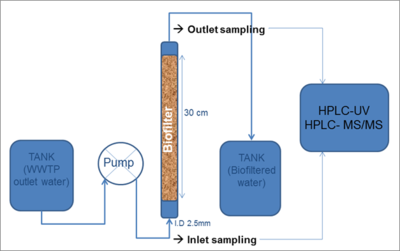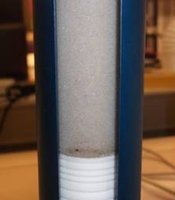Monica Escola Casa, PhD student,
Kai Bester, Senior Scientist
Soil filters, so called biofilters, can efficiently remove micro-pollutants from water by sorption and later chemical transformation or biodegradation1. Biofiltration systems are robust, easy to construct and require little energy. Therefore they are a remarkable technology for the removal of organic micro-pollutants2.
Effectiveness of biofilters depends on the retention time, layer composition and biological activity3. However, the most efficient biofilter configuration is indefinite and the mechanisms involved in the process are unclear.
In this project soil filters will be optimized in a way that sorption enhances retention time and the matrix supports biofilms able to degrade persistent pollutants. Removal of the compounds will be monitored with HPLC-MS/MS analysis. Besides, biodegradation processes will be verified by determining enantiomeric ratios of target chiral micro-pollutants before and after biofiltration using a 2-dimension LC separation. Finally, it is intended to implement knowledge from the bio-inorganic nanocatalysts into these systems to perform reactions otherwise not possible.

Setup for the column reactor

Detail of a laboratory-scale sand biofilter
Literature relevant for the project
1.Bester K, Schafer D. Activated soil filters (bio filters) for the elimination of xenobiotics (micro-pollutants) from storm- and waste waters. Water Research 2009; 43(10): 2639-46.
2.Reungoat J, Escher BI, Macova M, Keller J. Biofiltration of wastewater treatment plant effluent: Effective removal of pharmaceuticals and personal care products and reduction of toxicity. Water Research 2011; 45(9): 2751-62.
3.Andresen J, Bester K. Elimination of organophosphate ester flame retardants and plasticizers in drinking water purification. Water Research 2006; 40(3): 621-9.